生物油稳定性
- 格式:docx
- 大小:25.19 KB
- 文档页数:5
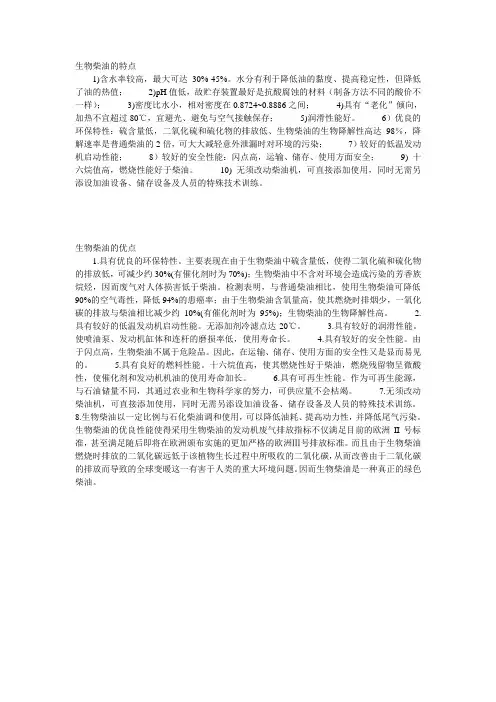
生物柴油的特点1)含水率较高,最大可达30%-45%。
水分有利于降低油的黏度、提高稳定性,但降低了油的热值;2)pH值低,故贮存装置最好是抗酸腐蚀的材料(制备方法不同的酸价不一样);3)密度比水小,相对密度在0.8724~0.8886之间;4)具有“老化”倾向,加热不宜超过80℃,宜避光、避免与空气接触保存;5)润滑性能好。
6)优良的环保特性:硫含量低,二氧化硫和硫化物的排放低、生物柴油的生物降解性高达98%,降解速率是普通柴油的2倍,可大大减轻意外泄漏时对环境的污染;7)较好的低温发动机启动性能;8)较好的安全性能:闪点高,运输、储存、使用方面安全;9) 十六烷值高,燃烧性能好于柴油。
10) 无须改动柴油机,可直接添加使用,同时无需另添设加油设备、储存设备及人员的特殊技术训练。
生物柴油的优点1.具有优良的环保特性。
主要表现在由于生物柴油中硫含量低,使得二氧化硫和硫化物的排放低,可减少约30%(有催化剂时为70%);生物柴油中不含对环境会造成污染的芳香族烷烃,因而废气对人体损害低于柴油。
检测表明,与普通柴油相比,使用生物柴油可降低90%的空气毒性,降低94%的患癌率;由于生物柴油含氧量高,使其燃烧时排烟少,一氧化碳的排放与柴油相比减少约10%(有催化剂时为95%);生物柴油的生物降解性高。
2.具有较好的低温发动机启动性能。
无添加剂冷滤点达-20℃。
3.具有较好的润滑性能。
使喷油泵、发动机缸体和连杆的磨损率低,使用寿命长。
4.具有较好的安全性能。
由于闪点高,生物柴油不属于危险品。
因此,在运输、储存、使用方面的安全性又是显而易见的。
5.具有良好的燃料性能。
十六烷值高,使其燃烧性好于柴油,燃烧残留物呈微酸性,使催化剂和发动机机油的使用寿命加长。
6.具有可再生性能。
作为可再生能源,与石油储量不同,其通过农业和生物科学家的努力,可供应量不会枯竭。
7.无须改动柴油机,可直接添加使用,同时无需另添设加油设备、储存设备及人员的特殊技术训练。

生物柴油技术的研究现状及应用前景随着全球气候变化问题的日益突出,各国之间加速推进清洁能源的开发和利用。
而生物能源作为其中之一,受到更多的关注和重视。
生物柴油,则是生物能源中一个备受关注的领域。
一、什么是生物柴油?生物柴油又称为绿色柴油或生质柴油。
它是一种由动植物油、动植物脂肪或废弃物转化而来的燃料,是一种可再生能源和低碳环保的燃料。
相对于传统柴油,生物柴油可以大幅减少二氧化碳的排放,减缓人类对环境的破坏,与此同时还具有较高的燃烧效率和稳定性。
二、生物柴油技术的研究现状1.生物柴油生产技术瓶颈问题生物柴油生产技术中,关键要素包括原料收购、生物柴油制备、储存、运输、加注等。
其中,生物柴油制备技术是生产中非常关键的环节。
目前,欧美和日本等发达国家已经基本掌握了生物柴油分类制备技术,但是生物柴油性质复杂、成分多样,其生产过程仍然存在着许多难题,如原料利用率较低,节能效果不尽人意,环保措施需要改善等。
2.关键技术的突破近年来,随着生物技术、化学工程、材料科学等领域的不断发展,生物柴油制备技术中出现了一些关键技术的突破,包括了酶催化、微生物发酵、化学催化等。
例如,酶催化技术利用了天然的酶或是人工启发的酶,可以在较低的温度下,高效、稳定地催化酯化反应,其制备的生物柴油品质较高,可以与传统柴油相媲美。
3.生物柴油高效催化技术生物柴油的催化制备技术经过不断的研究和实践,在高效转化废水、糠醛、生物油等废弃物转化成高质量的柴油方面已取得了显著的进展。
例如,固态催化技术的出现,可以显著降低催化过程中的中毒问题,并提高柴油品质;而金属氧化物等催化剂的应用,可以增强对复杂原料的适应能力,实现多种生物油废弃物的转化利用。
三、生物柴油的应用前景生物柴油的整个生产过程都充满了绿色环保和可持续性的理念,是一个高效、低排放、多元化市场的大有前景的发展领域。
1.生物柴油的市场前景随着全球节能减排目标的紧迫性和环保理念的深入人心,生物柴油作为一种具有潜在优势的生物燃料,在许多重要的国家中已经得到了广泛的应用和推广。
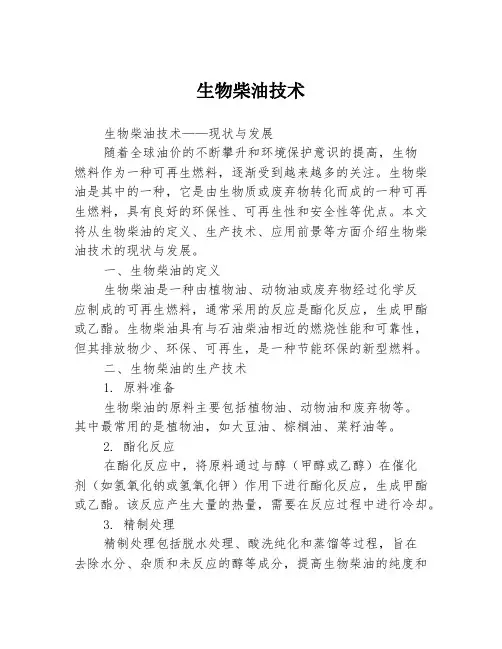
生物柴油技术生物柴油技术——现状与发展随着全球油价的不断攀升和环境保护意识的提高,生物燃料作为一种可再生燃料,逐渐受到越来越多的关注。
生物柴油是其中的一种,它是由生物质或废弃物转化而成的一种可再生燃料,具有良好的环保性、可再生性和安全性等优点。
本文将从生物柴油的定义、生产技术、应用前景等方面介绍生物柴油技术的现状与发展。
一、生物柴油的定义生物柴油是一种由植物油、动物油或废弃物经过化学反应制成的可再生燃料,通常采用的反应是酯化反应,生成甲酯或乙酯。
生物柴油具有与石油柴油相近的燃烧性能和可靠性,但其排放物少、环保、可再生,是一种节能环保的新型燃料。
二、生物柴油的生产技术1. 原料准备生物柴油的原料主要包括植物油、动物油和废弃物等。
其中最常用的是植物油,如大豆油、棕榈油、菜籽油等。
2. 酯化反应在酯化反应中,将原料通过与醇(甲醇或乙醇)在催化剂(如氢氧化钠或氢氧化钾)作用下进行酯化反应,生成甲酯或乙酯。
该反应产生大量的热量,需要在反应过程中进行冷却。
3. 精制处理精制处理包括脱水处理、酸洗纯化和蒸馏等过程,旨在去除水分、杂质和未反应的醇等成分,提高生物柴油的纯度和成品率。
三、生物柴油的应用前景生物柴油作为一种可再生燃料,其应用前景非常广泛。
一方面,生物柴油可以替代传统的石油柴油、汽油等化石能源,减少对化石能源的依赖,降低能源消耗和环境污染;另一方面,生物柴油可以直接应用于个人轿车、商用车、农用车以及城市公交车、出租车等交通工具,还可以应用于船舶、航空器等各类运输工具和农机具等机械设备。
总之,生物柴油技术已经成熟,其应用前景非常广阔,可以为促进能源转型和环境保护事业做出重要贡献。
生物柴油技术——优点和局限生物柴油是一种由生物质或废弃物转化而成的可再生燃料,可以替代传统的石油柴油,具有优良的环保性、可再生性和安全性等优点。
然而,生物柴油在应用中也存在一些局限性,限制了其在能源转型中的应用。
本文将从优点和局限两个方面来介绍生物柴油技术。
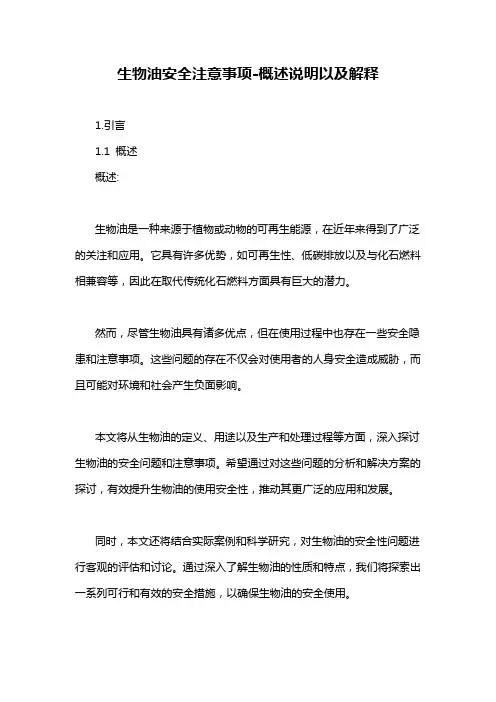
生物油安全注意事项-概述说明以及解释1.引言1.1 概述概述:生物油是一种来源于植物或动物的可再生能源,在近年来得到了广泛的关注和应用。
它具有许多优势,如可再生性、低碳排放以及与化石燃料相兼容等,因此在取代传统化石燃料方面具有巨大的潜力。
然而,尽管生物油具有诸多优点,但在使用过程中也存在一些安全隐患和注意事项。
这些问题的存在不仅会对使用者的人身安全造成威胁,而且可能对环境和社会产生负面影响。
本文将从生物油的定义、用途以及生产和处理过程等方面,深入探讨生物油的安全问题和注意事项。
希望通过对这些问题的分析和解决方案的探讨,有效提升生物油的使用安全性,推动其更广泛的应用和发展。
同时,本文还将结合实际案例和科学研究,对生物油的安全性问题进行客观的评估和讨论。
通过深入了解生物油的性质和特点,我们将探索出一系列可行和有效的安全措施,以确保生物油的安全使用。
在下文中,我们将进一步介绍生物油的定义和用途,并深入剖析生物油的生产和处理过程。
在此基础上,我们将引出生物油的安全性问题,并提供相应的安全注意事项,以保障使用者的安全。
敬请期待接下来关于生物油安全的精彩内容。
1.2 文章结构文章结构部分的内容如下:文章结构部分旨在介绍本篇长文的组织结构和各个部分的主要内容。
通过合理的组织结构,可以使读者更好地理解和掌握文章的主题内容。
本文分为引言、正文和结论三个部分。
引言部分包括概述、文章结构和目的三个小节。
在概述中,将简要介绍生物油的相关知识和背景,引起读者的兴趣。
然后,文章结构部分会详细介绍本文的组织结构,以便读者可以清晰地了解各个部分的内容安排。
最后,在目的部分,明确阐明本文的写作目的和意义。
正文部分是本文的核心部分,主要包括生物油的定义和用途以及生物油的生产和处理过程两个小节。
2.1节将介绍生物油的定义和用途,包括其在能源领域的应用以及环境保护方面的作用。
2.2节将详细描述生物油的生产和处理过程,包括原料选择、生产工艺和后续处理方法等内容,以帮助读者更好地了解和应用生物油。
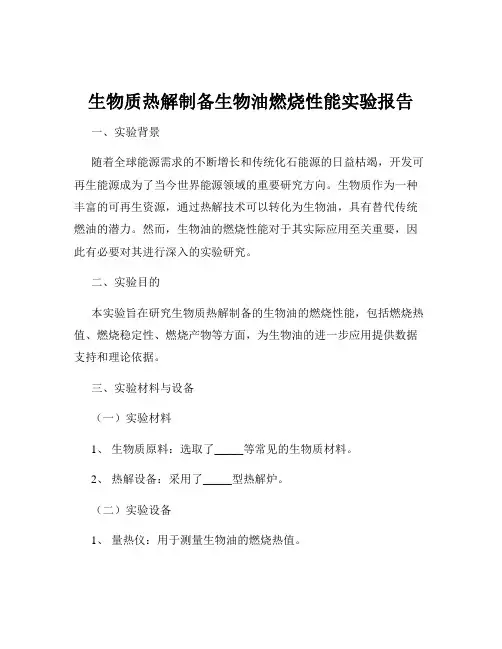
生物质热解制备生物油燃烧性能实验报告一、实验背景随着全球能源需求的不断增长和传统化石能源的日益枯竭,开发可再生能源成为了当今世界能源领域的重要研究方向。
生物质作为一种丰富的可再生资源,通过热解技术可以转化为生物油,具有替代传统燃油的潜力。
然而,生物油的燃烧性能对于其实际应用至关重要,因此有必要对其进行深入的实验研究。
二、实验目的本实验旨在研究生物质热解制备的生物油的燃烧性能,包括燃烧热值、燃烧稳定性、燃烧产物等方面,为生物油的进一步应用提供数据支持和理论依据。
三、实验材料与设备(一)实验材料1、生物质原料:选取了_____等常见的生物质材料。
2、热解设备:采用了_____型热解炉。
(二)实验设备1、量热仪:用于测量生物油的燃烧热值。
2、燃烧实验台:包括燃烧器、温度传感器、压力传感器等,用于模拟生物油的燃烧过程。
3、气体分析仪:用于分析燃烧产物中的气体成分。
四、实验方法(一)生物质热解将预处理后的生物质原料放入热解炉中,在_____的温度和_____的气氛条件下进行热解反应,得到生物油。
(二)燃烧热值测定使用量热仪,按照标准操作流程,对生物油样品进行燃烧热值测定。
(三)燃烧实验将生物油通过燃烧器进行燃烧,通过温度传感器和压力传感器实时监测燃烧过程中的温度和压力变化,记录燃烧时间和火焰形态等数据。
(四)燃烧产物分析使用气体分析仪对燃烧产物中的一氧化碳(CO)、二氧化碳(CO₂)、氮氧化物(NOₓ)等气体成分进行分析。
五、实验结果与分析(一)燃烧热值实验测定的生物油燃烧热值为_____kJ/kg。
与传统燃油相比,生物油的燃烧热值相对较低,这可能是由于其成分复杂,含有较多的含氧有机物和水分。
(二)燃烧稳定性在燃烧实验中,生物油的燃烧过程较为平稳,但燃烧初期存在一定的点火延迟现象。
燃烧过程中的温度和压力变化较为均匀,没有出现明显的波动,表明生物油具有较好的燃烧稳定性。
(三)燃烧产物燃烧产物分析结果显示,生物油燃烧产生的一氧化碳(CO)和氮氧化物(NOₓ)含量相对较低,二氧化碳(CO₂)排放量也在可接受范围内。
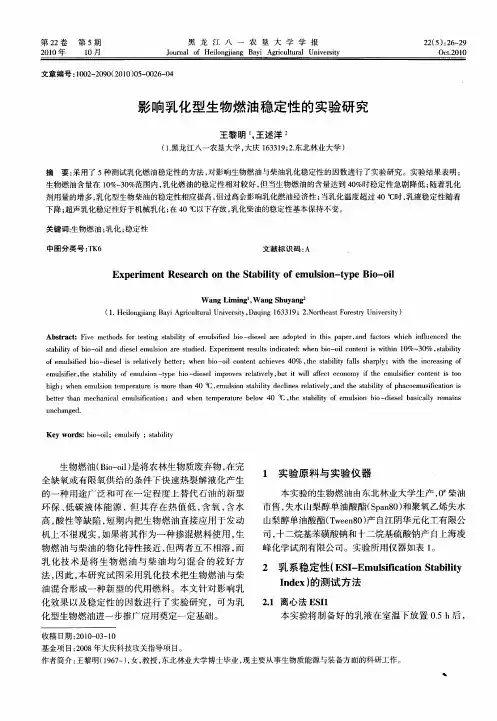
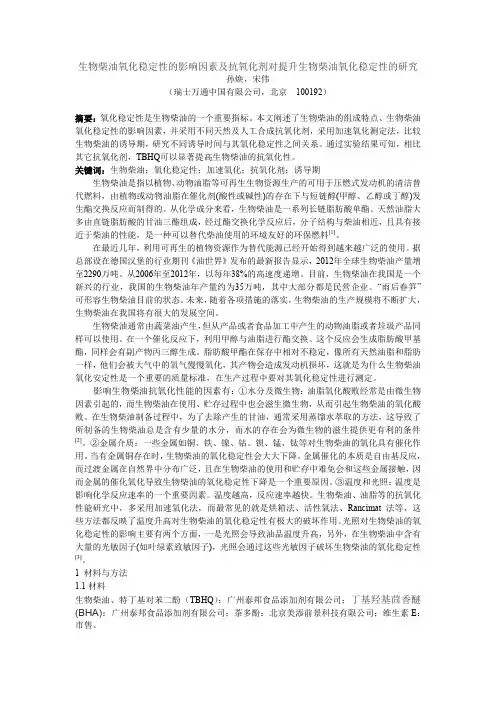
生物柴油氧化稳定性的影响因素及抗氧化剂对提升生物柴油氧化稳定性的研究孙焕,宋伟(瑞士万通中国有限公司,北京100192)摘要:氧化稳定性是生物柴油的一个重要指标。
本文阐述了生物柴油的组成特点、生物柴油氧化稳定性的影响因素,并采用不同天然及人工合成抗氧化剂,采用加速氧化测定法,比较生物柴油的诱导期,研究不同诱导时间与其氧化稳定性之间关系。
通过实验结果可知,相比其它抗氧化剂,TBHQ可以显著提高生物柴油的抗氧化性。
关键词:生物柴油;氧化稳定性;加速氧化;抗氧化剂;诱导期生物柴油是指以植物、动物油脂等可再生生物资源生产的可用于压燃式发动机的清洁替代燃料,由植物或动物油脂在催化剂(酸性或碱性)的存在下与短链醇(甲醇、乙醇或丁醇)发生酯交换反应而制得的。
从化学成分来看,生物柴油是一系列长链脂肪酸单酯。
天然油脂大多由直链脂肪酸的甘油三酯组成,经过酯交换化学反应后,分子结构与柴油相近,且具有接近于柴油的性能,是一种可以替代柴油使用的环境友好的环保燃料[1]。
在最近几年,利用可再生的植物资源作为替代能源已经开始得到越来越广泛的使用。
据总部设在德国汉堡的行业期刊《油世界》发布的最新报告显示,2012年全球生物柴油产量增至2290万吨。
从2006年至2012年,以每年38%的高速度递增。
目前,生物柴油在我国是一个新兴的行业,我国的生物柴油年产量约为35万吨,其中大部分都是民营企业。
“雨后春笋”可形容生物柴油目前的状态。
未来,随着各项措施的落实,生物柴油的生产规模将不断扩大,生物柴油在我国将有很大的发展空间。
生物柴油通常由蔬菜油产生,但从产品或者食品加工中产生的动物油脂或者垃圾产品同样可以使用。
在一个催化反应下,利用甲醇与油脂进行酯交换。
这个反应会生成脂肪酸甲基酯,同样会有副产物丙三醇生成。
脂肪酸甲酯在保存中相对不稳定,像所有天然油脂和脂肪一样,他们会被大气中的氧气慢慢氧化,其产物会造成发动机损坏,这就是为什么生物柴油氧化安定性是一个重要的质量标准,在生产过程中要对其氧化稳定性进行测定。
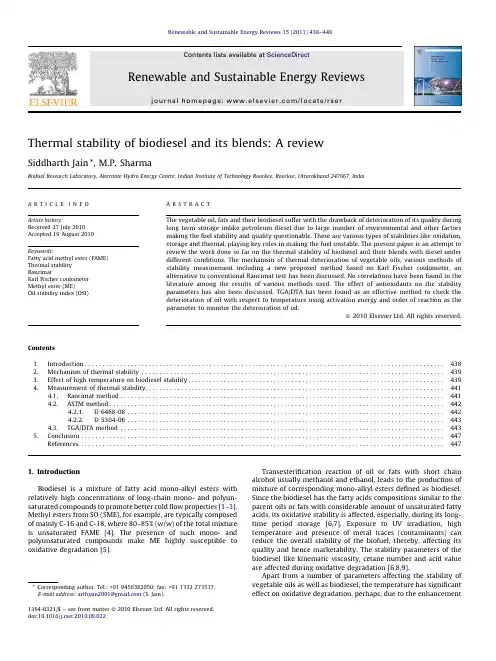
Thermal stability of biodiesel and its blends:A reviewSiddharth Jain *,M.P.SharmaBiofuel Research Laboratory,Alternate Hydro Energy Centre,Indian Institute of Technology Roorkee,Roorkee,Uttarakhand 247667,IndiaContents 1.Introduction .....................................................................................................4382.Mechanism of thermal stability .....................................................................................4393.Effect of high temperature on biodiesel stability........................................................................4394.Measurement of thermal stability....................................................................................4414.1.Rancimat method ...........................................................................................4414.2.ASTM method ..............................................................................................4424.2.1.D 6468-08.........................................................................................4424.2.2.D 5304-06.........................................................................................4434.3.TGA/DTA method ...........................................................................................4435.Conclusion ......................................................................................................447References ............................... (447)1.IntroductionBiodiesel is a mixture of fatty acid mono-alkyl esters with relatively high concentrations of long-chain mono-and polyun-saturated compounds to promote better cold flow properties [1–3].Methyl esters from SO (SME),for example,are typically composed of mainly C-16and C-18,where 80–85%(w/w)of the total mixture is unsaturated FAME [4].The presence of such mono-and polyunsaturated compounds make ME highly susceptible to oxidative degradation [5].Transesterification reaction of oil or fats with short chain alcohol usually methanol and ethanol,leads to the production of mixture of corresponding mono-alkyl esters defined as biodiesel.Since the biodiesel has the fatty acids compositions similar to the parent oils or fats with considerable amount of unsaturated fatty acids,its oxidative stability is affected,especially,during its long-time period storage [6,7].Exposure to UV irradiation,high temperature and presence of metal traces (contaminants)can reduce the overall stability of the biofuel,thereby,affecting its quality and hence marketability.The stability parameters of the biodiesel like kinematic viscosity,cetane number and acid value are affected during oxidative degradation [6,8,9].Apart from a number of parameters affecting the stability of vegetable oils as well as biodiesel,the temperature has significant effect on oxidative degradation,perhaps,due to the enhancementRenewable and Sustainable Energy Reviews 15(2011)438–448A R T I C L E I N F O Article history:Received 27July 2010Accepted 19August 2010Keywords:Fatty acid methyl ester (FAME)Thermal stability RancimatKarl Fischer coulometer Methyl ester (ME)Oil stability index (OSI)A B S T R A C TThe vegetable oil,fats and their biodiesel suffer with the drawback of deterioration of its quality during long term storage unlike petroleum diesel due to large number of environmental and other factors making the fuel stability and quality questionable.There are various types of stabilities like oxidation,storage and thermal,playing key roles in making the fuel unstable.The present paper is an attempt to review the work done so far on the thermal stability of biodiesel and their blends with diesel under different conditions.The mechanism of thermal deterioration of vegetable oils,various methods of stability measurement including a new proposed method based on Karl Fischer coulometer,an alternative to conventional Rancimat test has been discussed.No correlations have been found in the literature among the results of various methods used.The effect of antioxidants on the stability parameters has also been discussed.TGA/DTA has been found as an effective method to check the deterioration of oil with respect to temperature using activation energy and order of reaction as the parameter to monitor the deterioration of oil.ß2010Elsevier Ltd.All rights reserved.*Corresponding author.Tel.:+919456382050;fax:+911332273517.E-mail address:arthjain2001@ (S.Jain).Contents lists available at ScienceDirectRenewable and Sustainable Energy Reviewsj o u r n a l ho m e p a g e :w w w.e l s e v i e r.c o m /l o ca t e /r s e r1364-0321/$–see front matter ß2010Elsevier Ltd.All rights reserved.doi:10.1016/j.rser.2010.08.022in the rate of degradation thereby playing an important role in destabilizing the fuel quality which is the subject of the present paper.Thermal stability involves the measurement of the tendency of a fuel to produce asphaltenes,when exposed to high temperature conditions.These asphaltenes are tar like resinous substances generated in the fuel and plug the fuelfilters of the engines when used as fuel[10].2.Mechanism of thermal stabilityAt sufficiently high temperatures,the methylene-interrupted polyunsaturated olefin structure will begin to isomerize to more stable conjugated structure.Once this isomerization has begun,a conjugated diene group from one fatty acid chain can react with a single olefinic group from another fatty acid chain to form a cyclohexene ring[11,12].This reaction between a conjugated di-olefin and a mono-olefin group,called Diels Alder reaction and shown in Fig.1,is known as Diels Alder reaction which becomes important at temperatures of250–3008C or more and the reaction products formed are called dimmers[13–15].Thermal polymerization can also form trimers by the reaction of an isolated double bond in a dimer side chain with a conjugated diene from another fatty oil or ester molecule(a Diels Alder reaction)[15].However,an earlier study provided the evidence supporting the non-Diels Alder coupling of two-side chain olefin groups from a dimer and a fatty oil molecule[13].Thermal polymerization is characterized by rapid reduction in total unsaturation as all the three olefin groups become one.When linseed oil was thermally polymerized at3008C,initial polymeri-zation resulted in dramatic reduction of total unsaturation as measured by IV.However,no increase in molecular weight was observed.This was found to be due to an intra-molecular Diels Alder reaction between two fatty acid chains in the same triacylglyceride molecule.This may have ramifications for biodiesel made from used cooking oils that are subjected to temperatures in excess of3008C when used in high-pressure cookers.If such intramolecular dimers were to form during such thermal stressing,they would retain their linking when transes-terified to methyl esters for use as biodiesel.The resulting species would be a di-ester with a molecular weight about twice that of a normal biodiesel ester molecule.If such biodiesels(i.e.yellow greases)were not distilled,these dimers would appear in thefinal fuel.No work has however been reported that indicates the presence of such dimers in used cooking oils and if so,their effect on fuel properties of the corresponding non-distilled biodiesel fuels.The potential existence of such dimeric species in non-distilled yellow grease biodiesel has not been addressed in the published literature pertaining to the U.S.biodiesel manufactur-ing/marketing industry[15].The thermal polymerization may be of limited importance in biodiesel,which is heated repeatedly by the engine and recycled to the fuel tank before actual combustion.The thermal polymeriza-tion therefore does not impact the storage stability of biodiesel.3.Effect of high temperature on biodiesel stabilityVegetable oils consist of natural antioxidants that tend to increase the stability of fuel but as the vegetable oils are subjected to higher temperature conditions,the natural antioxidants present in the oil start deteriorating at a faster rate,thereby,decreasing its stability.As the biodiesel comes in contact with engine,it gets heated leading to the decrease in fuel stability.Bondioli et al.[16]evaluated the storage stability of biodiesel at different temperatures.Samples were kept at two different temperatures(208C and408C)during experimentation and it was found that increase in PV was higher at lower temperature while using the same container.NomenclatureF10IrgalubeL135IrganoxPO palm oilHO hydraulic oilTAN total acid numberIV iodine valueTGA thermo gravimetric analysisn order of reactionk reaction rate constantx extent of conversion or fractional weight loss w0original weightsw t current weightsw1final weightsT temperaturet timeE a activation energyR gas constantASTM American society of testing materialsDTA differential temperature analysisPDSC pressurized-differential scanning calorimetry TG thermo gravimetryOSI oil stability indexIP induction periodC/H carbon/hydrogen mass ratioHPLC high-performance liquid chromatographyAV acid valuePV peroxide valueKF Karl FischerFAME fatty acid methyl esterC-16:0palmitic acidC-18:1oleic acidUV ultra violetSME soybean oil methyl esterPPM parts per millionOSIcalc oxidation stability index calculatedUCOME used cooking oil methyl esterMO1methyl oleateSO soybean oilMO mixture of soybean oil and palm oilh hoursml milliliterl litern kinematic viscosityFig.1.Diels Alder reaction.S.Jain,M.P.Sharma/Renewable and Sustainable Energy Reviews15(2011)438–448439Dunn[17]has evaluated the effect of oxidation under accelerated conditions on fuel properties of methyl soyate.SME samples were collected from four different fuel producers. Oxidation reactions were conducted in the laboratory under varying time and temperature conditions.In order to determine the effects of oxidative degradation on biodiesel fuel,the reaction conditions were designed to produce measurable changes in most fuel properties in a relatively short time.Samples were placed in a three-necked round-bottomedflask and heated by a variant controlled mantle.Clean and dry air was bubbled slowly throughout the reaction using water-cooled condenser to mini-mize the evaporative losses.Airflow was manually regulated at a constant rate of0.5standard cm3/min(SCCM)with stirring of the reaction mixture to minimize wall effects and to keep the mixture homogeneous throughout the duration of the reaction.The results as shown in Figs.2–4indicate that with increase in reaction temperature,viscosity,acid value and peroxide value respectivelyincreased significantly including specific gravity whereas,the cold flow properties were minimally affected for temperature up to 1508C.Fig.2shows the variation of kinematic viscosity of SME calculated at408C with respect to reaction temperature.It is clear from thefigure that the viscosity increases linearly as the temperature of the reaction is increased.The possible reason for this behavior may be due to Diels Alder reaction which leads to the formation of polymers at higher temperatures.The variation in acid value with respect to reaction temperature as given in Fig.3which shows that with increase in reaction temperature,the acid value decreases linearly.Thermal degrada-tion is the responsible for increase in AV with increasing temperature.The variation of PV with reaction temperature is shown in Fig.4. It is clear from the graph that as the reaction temperature increases,the PV decreases linearly,perhaps,due to the absence of oxygen or acceleration of decomposition of hydroperoxides with increase in temperature.Xin et al.[18]studied the oxidation stability of biodiesel prepared from supercritical methanol method.The effect of temperature on the tocopherol content in biodiesel was studied by choosing rapeseed biodiesel as a representative biodiesel. Rapeseed biodiesel was exposed to supercritical methanol at 2708C/17MPa,3008C/20MPa,3308C/37MPa,and3608C/47MPa for30min,the remaining tocopherol content in rapeseed biodiesel was measured and the results are shown in Fig.5which indicates that with increase in temperature above3008C,the remaining tocopherol decreased with an increase in temperature.While a further temperature increase led to the significant reduction in the tocopherols content.These observations clearly indicated that the tocopherol in biodiesel is not stable at a temperature>3008C.The biodiesel obtained through supercritical method will therefore have overall lower stability compared to biodiesel prepared using other methods of transesterification[16,18–20].Dunn[19]studied the effect of temperature on the oil stability index(h)of biodiesel and found that an increasing temperature accelerated the oxidation reaction causing a decrease of OSI as shown in Fig.6.The variation in calculated oxidation stability index as a function of oxidation stability(OSIcalc)of SME,UCOME and MO1 with respect to reaction temperature is shown in Fig.6which indicates the decrease in OSIcalc as the temperature is increased. At higher temperature,the rate of polymer formation is increasedFig.2.Kinematic viscosity(n)of oxidized SME at408C vs reaction temperature (T)[17].Fig.3.AV of oxidized SME vs reaction temperature(T)[17].Fig.4.PV of oxidized SME vs reaction temperature(T)[17].Fig.5.Effect of temperature on the tocopherol content in rapeseed biodiesel as treated in supercritical methanol[18].S.Jain,M.P.Sharma/Renewable and Sustainable Energy Reviews15(2011)438–448 440resulting in the increase in viscosity and acid value and decrease in PV as reported by Dunn[17]and ultimately in the decrease in the OSI.Nzikou et al.[20]studied the thermal stability of vegetable oils during frying and found a decrease in Linoleic acid contents with increase in frying hours of oil.Relationship between%linoleic acid with frying hours for SO and MO frying temperature of1808C as shown in Fig.7indicates that the linoleic content decreases with increase in frying hours due to lipid oxidation[20].It is clear from thefigure that the relation between%linoleic acid and frying time with standard deviation(R2)as0.9818and0.9892can be used to assess the stability aspect to the extent of98.18%and98.92%for SO and MO respectively.The relationship between viscosity at208C and frying hours for both SO and MO at frying temperature of1808C is given in Fig.8 which shows that the viscosity of oils increases with increase in frying days due to the formation of high molecular weight polymers.Higher the viscosity of frying oil,higher will be the degree of deterioration[20].This is in agreement with thefindings of Dunn[17].The abovefigure shows that the relationship with higher values of standard deviation(R2)as0.9893and0.991can be used to the extent of98.93%and99.1%for SO and MO respectively.4.Measurement of thermal stabilityVarious procedures designed to accelerate the oxidative and/or thermal instability of fatty oils have been developed or adapted from similar procedures used in other industries most notably the fuels and lubricants industries.However,the most important procedures related to thermal stability are given below:4.1.Rancimat methodThe length of time before the rapid acceleration of oxidation is the measure of the resistance to oxidation and is commonly referred to as the‘induction period,or Oxidative Stability Index (OSI)The OSI test is the commonly used test in Europe where biodiesel fuels should meet the specification of an induction period (IP)of at least6h when tested at1108C[21].The Metrohm Rancimat apparatus is frequently used to measure OSI and the term‘‘Rancimat’’and‘‘OSI’’are often used interchangeably in the literature while referring to the test method.OSI,commonly used in experiments,requires to pass air through a heated sample of the fatty oil or ester[16,22,23].The air coming out of the sample is finally passed through water contained in a tubefitted with a conductivity meter(Fig.9).A sharp rise in conductivity is interpreted as indicative of the formation of short chain,water soluble carboxylic acids,i.e.,secondary oxidation products (Fig.12).Studies have indicated that the primary acidic species formed in the Rancimat OSI test is formic acid.The mechanism of decomposition of hydroperoxides to form formic acid has been explained by Hasenhuettl et al.[25].An alternative approach has been reported where chemiluminescence is used to monitor the oxidation during the OSI test[24].Fig.6.OSIcalc of SME,UCOME and MO1as a function of temperature(T)[19].Fig.7.Relationship between linoleic acid degradation and the frying time of SO and mixture of MO[20].Fig.8.Relationship between viscosity(measured at208C)and the frying during for SO and mixture of MO[20]Fig.9.Schematic of Rancimat test[25–27].S.Jain,M.P.Sharma/Renewable and Sustainable Energy Reviews15(2011)438–448441Fig.10shows that as the temperature of Rancimat test is increased,the value of induction period decreases.The period of sudden increase in conductivity is called as induction period(e.g. 6h in this case).Different oils have different induction periods. Several studies have shown that when the Rancimat test is conducted at different temperatures,the logarithm of the induction period(IP)will be a linear function of test temperature, i.e.plots of log(OSI IP)vs T give straight lines[25–28].This suggested that biodiesel stored at lower temperature is favorable for long-time storage of biodiesel without degradation.The Rancimat test has used to measure the thermal stability by not using an airflow but by measuring the polymer content in8g biodiesel sample after6h at2008C[21].The test seems to be suitable for use in terms of repeatability and easiness to handle.Paolo et al.[16]found that the decrease in Rancimat induction period is faster at208C than408C with respect to time,though the difference between two temperatures is very less.This may be due to high PV and high AV at lower temperature.Xin et al.[28]studied the effect of temperature on induction period of safflower oil and found that as the reaction temperature increases,induction period is decreased.The relationship between logarithms of induction periods(ln IP)determined by Rancimat method with temperature is reported for various biodiesels and mixtures of biodiesel are shown in Fig.11[28].Intercepts of lines represent that the biodiesels having the same induction period at1108C,but with different long-time storage stabilities.As a result,the Rancimat method gives only approxi-mate information about the stability of biodiesel and long induction period does not necessarily represent the long storage stability because of the different temperature coefficients for biodiesel obtained from different sources.Alternatively,the Rancimat test can also be performed manually using the Karl Fischer Coulometer make Metrohm (model no.831KF)as shown schematically in Fig.12.There is an internal pump to suck the air.The airflow rate and the temperature of the oven can be precisely adjusted.A well calibrated digital conductivity meter can be installed externally in the measuring cell.The apparatus can be used to check the oxidation as well as thermal stability.Air supply is closed at the time of measurement of thermal stability.However,the remaining part of the experimentation is same as that of Rancimat test. Therefore,it may be used as an alternative method as Rancimat test,though the validation of the former is under progress in our research laboratory.4.2.ASTM method4.2.1.D6468-08[29]It gives an indication of thermal oxidative stability of distillate fuels when heated to high temperatures occurring in recirculating engines or burner fuel delivery systems.Results have not been substantially correlated to the engine or burner operation.The test method can be useful for the investigation of operational problems related to fuel thermal stability.In the test,two samples of50-ml each offiltered middle distillate fuel are aged for90or180min at1508C exposed to air. After aging and cooling,the fuel samples arefiltered and the averagefilterable insolubles are estimated by measuring the light reflectance of thefilter pads.The100%and0%extremes of the reflectance rating range are defined by an unusedfilter pad and a commercial black standard respectively.The test method makes use of afilter paper with a nominal porosity of11m m which does not capture all the sediment formed during aging but allows differentiation over a broad range. Reflectance ratings are also affected by the color offilterable insolubles that may not correlate with the mass of the material filtered from the aged fuel sample.Therefore,no quantitative relationship exists between the pad rating and the gravimetric mass offilterable insolubles.ASTM D6468has existed in nearly the same form(albeit different names)for over60years.Its very short time of90-min test time makes it a very attractive test for quality assurance and quality control.The1508C test temperature makes this test quite severe.There is no active addition of air or oxygen to the fuel during testing so this test is not as useful for measuring oxidation stability.Also,this test method has historically relied on estimating the amount of insolubles formed based on the darkness of the material trapped on afilter pad.Biodiesel insolubles tend to be far less dark in color than petroleum diesel and as such,are moreFig.10.Conductivity vs time in Rancimat test.Fig.11.ln IP vs temperature for various biodiesel and mixtures of biodiesel[28].Fig.12.Alternative Rancimat test using Karl Fischer(831KF).S.Jain,M.P.Sharma/Renewable and Sustainable Energy Reviews15(2011)438–448 442difficult to quantify using optical methods.Gravimetric measure-ment of insolubles provides more reliable quantification.Biodiesel tends to be very thermally stable but less stable oxidatively when compared to petroleum diesel.This test method does not provide a useful discrimination between biodiesel fuels of varying quality. This test may,however,be useful for B20but more work is still required to be done as the repeatability of results is not acceptable [21].4.2.2.D5304-06[30]A100ml aliquot offiltered fuel is taken in a borosilicate glass container placed in a pressure vessel already preheated to908C. The pressure vessel is pressurized with O2to800kPa(absolute) (100psig)for the duration of the test.The pressure vessel is placed in a forced air oven at908C for16h(taking all normal precautions while using oxygen under pressure and at high temperatures in the presence of combustible liquids.Appropriate shielding should be used for any containers under pressure.The container is pressurized and depressurized slowly using appropriate personnel shielding).After aging and cooling,the total amount of fuel insoluble products is determined gravimetrically and corrected according to blank determinations.Schematic offiltration system is shown in Fig.13used tofilter the sample and to measure thefilterable insolubles.It consists of a vacuum pump to create vacuum within the receivingflask at a pressure of800kPa(absolute).It consists of a receivingflask of1.5l to which thefiltration apparatusfits into,equipped with a side arm to connect to the safetyflask to which vacuum pump is connected.Several studies have found the excellent thermal stability result when measured by ASTM D6468[31–34].In one study,the method was modified to measure thefilterable insolubles formed during the908C and180min thermal stressings.All the neat biodiesel and blends of biodiesel with No.2diesel fuel were found to be very stable.The BIOSTAB project also showed excellent thermal stability using D6468[21].However,when the severity of thermal stability test procedure was increased using Rancimat apparatus at 2008C without airflow,significant evidence of instability was observed in terms of significant increase especially,in total acid number(TAN)and viscosity in all the eight methyl ester samples. Polymer levels were also greatly increased withfinal values ranging from5.5%to18.2%(w/w).The biodiesel fuels were found to have good thermal stability as they are derived from vegetable oils known to be well-suited for high temperature cooking applications such as deep-fat frying and pressure cooking[21].4.3.TGA/DTA methodThermal stability of oils depends on their chemical structures. Oils with a high proportion of unsaturated fatty acids are less stable than the saturated ones[35].In the recent years,thermal analysis was successfully used to study the physical properties, chemical reaction and the thermal stability of oils.Thermoana-lytical methods specially thermogravimetry analysis(TGA)has the advantages of being precise,sensitive and fast needing small amount of sample[35].Thermo analytical methods include a group of techniques in which the thermal behavior or thermal properties of a material are determined as a function of temperature.The thermal tests measure the change of weight and enthalpy as the sample is heated.TGA has been used extensively in polymer science for measurement of degradation of polymer[36–38].The equipment continuously monitors the loss of sample weight while the sample is heated in isothermal or dynamic conditions.Thermal analysis techniques have been used for the characterization of edible oils and fats by studying several properties such as thermo-oxidative behavior and stability[39–41],specific heat[42],thermal decomposition activation energy[43],temperature and enthalpy of crystallization[44–47],effect of antioxidants on thermal stability of oils[43,48],degree of unsaturation from melting and crystallization oil profile curves[49]and high-pressure oxidation induction period measurements[50].Thermogravimetric analysis is normally carried out either in the presence of air or in an inert atmosphere,e.g.,N2,He,Ar and the weight loss is recorded as a function of increasing temperature.The measurements are,sometimes,performed in O2atmosphere(1–5% O2in N2or He)and sometimes in a lean oxygen atmosphere(1–5% O2in N2or He)to slow down oxidation process.Some instruments also record the temperature difference between the sample and one or more reference pans(differential thermal analysis or DTA) or the heatflow into the sample pan compared to that of the reference pan(Differential Scanning Calorimetry,or DSC).The later can be used to monitor the energy released or absorbed via chemical reactions during the heating process.In most cases,TGA analysis is performed in an oxidative atmosphere(air or oxygen and inert gas mixtures)with a linear temperature ramp.The maximum temperature is selected so that the sample weight is stable at the end of the experiment,implying that all chemical reactions have been completed.The onset temperatures(T on)as shown in Fig.14can be used to indicate the resistance of the oil to thermal degradation determined by extrapolating the horizontal baseline at1% degradation.The intercept of this line with the tangent to the downward portion of the weight curve was defined as the onset temperature.As the oil is oxidized,its onset temperature decreases[35].Thermogravimetric data were used in characterizing the materials as well as in investigating the thermodynamics and kinetics of the reactions and transitions that resulting from the application of the oil samples.Currently,several methods are available in the literature that can be used to calculate the kinetic parameters.The kinetics used for the thermal conversion of the oil is similar to that reported by Torrente and Gala´n[51]and Jaber and Probert[52].Two models may be used to evaluate the kinetic parameters of the oil samples.For the direct Arrhenius plot method for the non-isothermal kinetic parameters with constant heating rate(B=d T/ d t),is given below:ln1ð1ÀxÞd xd t¼lnABÀE aRT:(1)The plot ln[(1/(1Àx))(d x/d t)]vs1/T should give a straight line with slopeÀE a/R,from which the activation energy,E a,can be calculated.Fig.13.Schematic offiltration system[30].S.Jain,M.P.Sharma/Renewable and Sustainable Energy Reviews15(2011)438–448443。
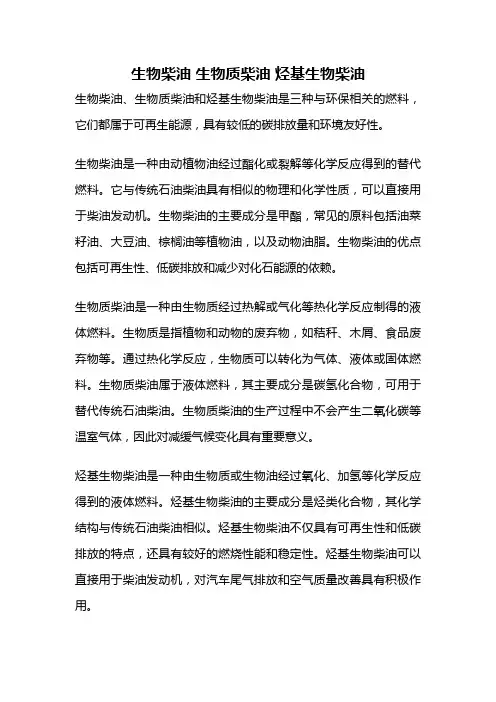
生物柴油生物质柴油烃基生物柴油生物柴油、生物质柴油和烃基生物柴油是三种与环保相关的燃料,它们都属于可再生能源,具有较低的碳排放量和环境友好性。
生物柴油是一种由动植物油经过酯化或裂解等化学反应得到的替代燃料。
它与传统石油柴油具有相似的物理和化学性质,可以直接用于柴油发动机。
生物柴油的主要成分是甲酯,常见的原料包括油菜籽油、大豆油、棕榈油等植物油,以及动物油脂。
生物柴油的优点包括可再生性、低碳排放和减少对化石能源的依赖。
生物质柴油是一种由生物质经过热解或气化等热化学反应制得的液体燃料。
生物质是指植物和动物的废弃物,如秸秆、木屑、食品废弃物等。
通过热化学反应,生物质可以转化为气体、液体或固体燃料。
生物质柴油属于液体燃料,其主要成分是碳氢化合物,可用于替代传统石油柴油。
生物质柴油的生产过程中不会产生二氧化碳等温室气体,因此对减缓气候变化具有重要意义。
烃基生物柴油是一种由生物质或生物油经过氧化、加氢等化学反应得到的液体燃料。
烃基生物柴油的主要成分是烃类化合物,其化学结构与传统石油柴油相似。
烃基生物柴油不仅具有可再生性和低碳排放的特点,还具有较好的燃烧性能和稳定性。
烃基生物柴油可以直接用于柴油发动机,对汽车尾气排放和空气质量改善具有积极作用。
总的来说,生物柴油、生物质柴油和烃基生物柴油是未来替代传统石油柴油的重要能源。
它们的生产和使用可以减少温室气体排放,改善空气质量,促进可持续发展。
然而,由于生物柴油和生物质柴油的生产需要大量的农作物和土地资源,可能会对粮食安全和生态环境产生一定的影响。
因此,在推广使用这些燃料的同时,需要合理规划资源利用,加强科研和技术创新,提高生产效率和环境友好性。
只有在经济、环境和社会效益的平衡中,生物柴油、生物质柴油和烃基生物柴油才能真正发挥作用,为可持续能源的发展做出贡献。
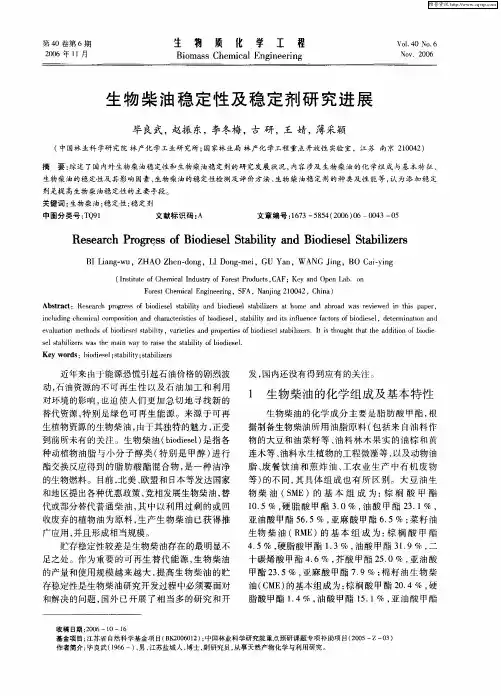
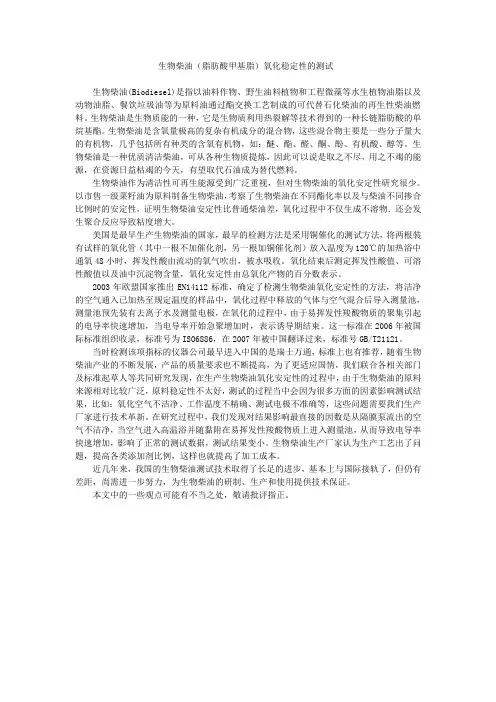
生物柴油(脂肪酸甲基脂)氧化稳定性的测试生物柴油(Biodiesel)是指以油料作物、野生油料植物和工程微藻等水生植物油脂以及动物油脂、餐饮垃圾油等为原料油通过酯交换工艺制成的可代替石化柴油的再生性柴油燃料。
生物柴油是生物质能的一种,它是生物质利用热裂解等技术得到的一种长链脂肪酸的单烷基酯。
生物柴油是含氧量极高的复杂有机成分的混合物,这些混合物主要是一些分子量大的有机物,几乎包括所有种类的含氧有机物,如:醚、酯、醛、酮、酚、有机酸、醇等。
生物柴油是一种优质清洁柴油,可从各种生物质提炼,因此可以说是取之不尽,用之不竭的能源,在资源日益枯竭的今天,有望取代石油成为替代燃料。
生物柴油作为清洁性可再生能源受到广泛重视,但对生物柴油的氧化安定性研究很少。
以市售一级菜籽油为原料制备生物柴油,考察了生物柴油在不同酯化率以及与柴油不同掺合比例时的安定性,证明生物柴油安定性比普通柴油差,氧化过程中不仅生成不溶物.还会发生聚合反应导致粘度增大。
美国是最早生产生物柴油的国家,最早的检测方法是采用铜催化的测试方法,将两根装有试样的氧化管(其中一根不加催化剂,另一根加铜催化剂)放入温度为120℃的加热浴中通氧48小时,挥发性酸由流动的氧气吹出,被水吸收。
氧化结束后测定挥发性酸值、可溶性酸值以及油中沉淀物含量,氧化安定性由总氧化产物的百分数表示。
2003年欧盟国家推出EN14112标准,确定了检测生物柴油氧化安定性的方法,将洁净的空气通入已加热至规定温度的样品中,氧化过程中释放的气体与空气混合后导入测量池,测量池预先装有去离子水及测量电极,在氧化的过程中,由于易挥发性羧酸物质的聚集引起的电导率快速增加,当电导率开始急聚增加时,表示诱导期结束。
这一标准在2006年被国际标准组织收录,标准号为ISO6886,在2007年被中国翻译过来,标准号GB/T21121。
当时检测该项指标的仪器公司最早进入中国的是瑞士万通,标准上也有推荐,随着生物柴油产业的不断发展,产品的质量要求也不断提高,为了更适应国情,我们联合各相关部门及标准起草人等共同研究发现,在生产生物柴油氧化安定性的过程中,由于生物柴油的原料来源相对比较广泛,原料稳定性不太好,测试的过程当中会因为很多方面的因素影响测试结果,比如:氧化空气不洁净、工作温度不精确、测试电极不准确等,这些问题需要我们生产厂家进行技术革新。
生物柴油制备技术的优缺点分析生物柴油(Biodiesel)是一种以植物油、动物脂肪或废弃料为原料,经酯化或转酯化制成的可代替传统石油柴油的燃料。
近年来,随着环保意识的提高,生物柴油的使用逐渐受到越来越多的关注。
本文将从生物柴油制备技术的角度出发,对其优缺点进行分析。
优点:1.生物柴油可再生相比传统石油柴油,生物柴油是一种可再生资料。
由于其主要原料为植物油、动物脂肪或废弃料,这些原料可以通过种植、饲养等方式进行再生,产生的生物柴油也可以被再生利用,降低了对于化石燃料的依赖,减少了对于环境的污染。
2.生物柴油环保生物柴油的主要原料为植物油、动物脂肪或废弃料,这些资料在生长、生产过程中会吸收二氧化碳,并在酯化反应中释放出来,形成一个封闭的生态循环系统,减少了温室气体的排放量。
同时,生物柴油燃烧过程产生的尾气排放较少,其一氧化碳、氮氧化物、颗粒物和有害气体的排放远低于传统石油柴油,其环保性能得到了广泛的认可。
3.生物柴油可融合现有石油基础设施生物柴油与传统石油柴油具有相似的物理和化学性质,所以生物柴油完全可以融合现有的石油基础设施中进行生产、销售和使用,使其成本显著降低。
缺点:1.生物柴油生产过程复杂生物柴油的生产过程较为复杂,需要经过多个步骤的处理,如去酸、去水、甲酸等处理,使得其生产成本较高。
同时,由于生物柴油的原料来源较为广泛,不同原料的处理步骤略有差异,这也增加了生产过程的复杂度。
2.生物柴油产量较低相较于传统石油柴油,生物柴油生产的累动机批年产量相对较低,这也导致其价格较高,难以大规模应用。
3.生物柴油稳定性较低生物柴油在运输、储存和使用过程中容易发生沉淀、生锈、泄漏等问题,需要对于其进行加工和处理,增加使用成本。
结语:总体而言,生物柴油具有可再生、环保和可融合现有石油基础设施的优点,然而其价格较高、生产过程复杂以及产量较低和稳定性较低等缺点也是不能忽略的。
未来在生物柴油生产技术和成本方面的持续改进,将有望进一步提高生物柴油的竞争力和应用价值。
1983年美国科学家Graham Quick将亚麻棉籽油的甲酯用于发动机,并将可再生的油脂原料经过酯交换反应得到的脂肪酸单酯定义为生物柴油(biodiese1),从此以后,生物柴油得到了大力发展,在替代能源上占有重要地位。
1生物柴油的标准生物柴油的生产应该有标准作指导来保证其品质,同时标准化也是市场准入的一个重要条件,生物柴油的发展刺激着生物柴油标准的建立。
1992年奥地利制定了世界上第一个以菜籽油甲酯为基准的生物柴油标准。
很快德国、法国、捷克和美国也分别建立了各自的生物柴油标准。
生物柴油可以由不同的植物油制成,这些植物油种类不同,产地气候各异,甘三酯组成有较大差别,因而各国的标准存在着些差异。
除去经济、健康和环境方面的好处外,标准的建立增强了生物柴油使用者、发动机生产商和其他团体的信心,成为其商业化应用的一个里程碑。
2 生物柴油标准的解读和质量控制生物柴油的质量指标可以分成二类,第一类密度、粘度、闪点、残碳量、灰分和十六烷值等,石化柴油也有这些指标;另一类如甲醇含量、甘油酯、游离脂肪酸和含磷量等衡量生物柴油的杂质成分,与原料和工艺过程有关,石化柴油没有这些成分。
质量指标还可以按影响因素分类,一类主要受原料的影响如密度、十六烷值、含硫量和冷滤点,另一类则与生产方法和提纯步骤有关,如闪点受甲醇影响,粘度则与甘油酯含量有很大关系。
2.1 密度2号柴油的密度约为0.85,生物柴油的密度比柴油高2%-7%,在0.86和0.90之间,大多在0.88左右。
2.2 粘度为了保证燃油具有较好的雾化性能,应尽量降低生物柴油的粘度,以避免压力过大。
植物油的粘度是石化柴油的十倍以上,高粘度是其雾化不佳,产生喷口炼焦和沉积的主要原因。
制成生物柴油后,粘度大大降低 J。
残留甘油和甘油酯会大大增加生物柴油的粘度。
因而在标准中对甘油和甘油酯含量作了严格限制。
2.3 馏程生物柴油中的各种脂肪酸甲酯结构较为相似,沸点范围较窄,大致在325 ℃和350℃ 之间,馏程影响燃料的表现和安全性,影响发动机的启动和暖化,馏程还用在十六烷值(CN值)的估算中。
标准的生物柴油质量指标介绍关于标准的生物柴油质量指标介绍生物柴油标准篇一:生物柴油质量指标1983年美国科学家GrahamQuick将亚麻棉籽油的甲酯用于发动机,并将可再生的油脂原料经过酯交换反应得到的脂肪酸单酯定义为生物柴油(biodiese1),从此以后,生物柴油得到了大力发展,在替代能源上占有重要地位。
1生物柴油的标准生物柴油的生产应该有标准作指导来保证其品质,同时标准化也是市场准入的一个重要条件,生物柴油的发展刺激着生物柴油标准的建立。
1992年奥地利制定了世界上第一个以菜籽油甲酯为基准的生物柴油标准。
很快德国、法国、捷克和美国也分别建立了各自的生物柴油标准。
生物柴油可以由不同的植物油制成,这些植物油种类不同,产地气候各异,甘三酯组成有较大差别,因而各国的标准存在着些差异。
除去经济、健康和环境方面的好处外,标准的建立增强了生物柴油使用者、发动机生产商和其他团体的信心,成为其商业化应用的一个里程碑。
2生物柴油标准的解读和质量控制生物柴油的质量指标可以分成二类,第一类密度、粘度、闪点、残碳量、灰分和十六烷值等,石化柴油也有这些指标;另一类如甲醇含量、甘油酯、游离脂肪酸和含磷量等衡量生物柴油的杂质成分,与原料和工艺过程有关,石化柴油没有这些成分。
质量指标还可以按影响因素分类,一类主要受原料的影响如密度、十六烷值、含硫量和冷滤点,另一类则与生产方法和提纯步骤有关,如闪点受甲醇影响,粘度则与甘油酯含量有很大关系。
2.1密度2号柴油的密度约为0.85,生物柴油的密度比柴油高2%-7%,在0.86和0.90之间,大多在0.88左右。
2.2粘度为了保证燃油具有较好的雾化性能,应尽量降低生物柴油的粘度,以避免压力过大。
植物油的粘度是石化柴油的十倍以上,高粘度是其雾化不佳,产生喷口炼焦和沉积的主要原因。
制成生物柴油后,粘度大大降低J。
残留甘油和甘油酯会大大增加生物柴油的粘度。
因而在标准中对甘油和甘油酯含量作了严格限制。
专利名称:通过添加复合添加剂提高生物油稳定性的方法专利类型:发明专利
发明人:刘荣厚,张乐,梅远飞
申请号:CN201410243326.7
申请日:20140603
公开号:CN104059701A
公开日:
20140924
专利内容由知识产权出版社提供
摘要:本发明公开了一种通过添加复合添加剂提高生物油稳定性的方法,步骤为:第一步,生物质原料准备:采用粉碎的稻壳,筛选后,干燥处理;第二步,生物油的制取:将干燥后稻壳采用鼓泡流化床生物质快速热裂解装置裂解反应;第三步,筛选复合添加剂;第四步,向生物油中添加复合添加剂,混合均匀,置于密闭容器中进行储存。
本发明采用复合添加剂加入到生物油,生物油的稳定性得到了明显提高,与单一添加剂相比,复合添加剂能够显著降低生物油的运动粘度值;本发明不需对生物油进行复杂的加工处理;操作成本低,不需要昂贵的设备和其他严格的控制条件。
本发明能够有效提高生物油稳定性,并且显著降低生物油粘度,在25℃下能有效存贮90天以上。
申请人:上海交通大学
地址:200240 上海市闵行区东川路800号
国籍:CN
代理机构:上海汉声知识产权代理有限公司
代理人:郭国中
更多信息请下载全文后查看。
生物油如何引起火灾事故一、生物油引发火灾的原因生物油引发火灾的主要原因包括以下几点:1. 高温生物油具有较低的沸点和闪点,一旦受到高温环境的影响,易于挥发和着火。
在烹饪过程中,如锅中的生物油过热,可能造成火灾。
2. 氧气生物油在空气中易受氧气氧化而产生燃烧所需的热量,一旦与空气中的氧气接触,可能引发火灾。
3. 火源如明火、电火花等能量源,都可能引发生物油的着火。
4. 不稳定性某些生物油在受潮、氧化或光照的情况下,可能产生化学反应,导致着火。
二、生物油火灾的预防措施为了预防生物油引发的火灾事故,下面列举了一些预防措施:1. 选择适当的储存容器应选择耐热、密封性好的储存容器,避免生物油受潮氧化。
同时,要保持储存容器清洁,避免生物油混入杂质。
2. 控制温度在烹饪过程中,应控制油温,避免生物油过热。
在工业生产中,应配备恰当的冷却装置,控制储存环境温度。
3. 防止氧化在生物油的生产加工过程中,应加入抗氧化剂,延长生物油的寿命,避免其在储存过程中产生不稳定的化学反应。
4. 防止接触火源在使用和储存生物油时,要避免接触火源,如明火、电火花等。
5. 定期检查定期检查生物油的保存情况,确保储存容器完好无损,并清洁环境,避免火灾隐患的产生。
三、生物油火灾的应急处理方法一旦发生生物油火灾事故,应采取立即的应急处理方法,以避免事态进一步恶化。
1. 避免直接用水灭火由于生物油容易与水发生化学反应,产生大量的热量和蒸汽,使火势扩大,因此不宜直接用水灭火。
2. 使用灭火器应选用适合灭油火的灭火器材,如泡沫灭火器、二氧化碳灭火器等进行灭火。
3. 避免吸入有毒气体在灭火过程中,应避免吸入生物油燃烧释放的有毒气体,应及时撤离现场,并采取保护措施。
4. 避免直接接触燃烧的生物油在灭火过程中,要避免直接接触燃烧的生物油,以免烫伤皮肤。
5. 及时报警一旦发生生物油火灾事故,应立即报警,寻求专业的灭火救援人员的帮助。
综上所述,生物油容易引发火灾,但通过预防措施和应急处理方法,可以有效降低生物油引发火灾事故的风险。
●生物油含大量有机酸(5一10%),pH值一般为2一4,酸度为50一100mg(KOH),会对一些普通的金属材料如铝、碳钢等产生强烈的腐蚀,耐生物油腐蚀的材料主要包括不锈钢等金属材料以及各种聚合物如聚乙烯、聚丙烯和聚醋等。
●生物油应该在室温下存储于密封的不锈钢或聚合物制成的容器中,并避免阳光直射。
需要长时间保存(如3个月以上),最好采用添加甲醇等助剂来提高生物油存储的稳定性,添加量一般为10%。
●提取物?●生物油含有固体炭颗粒,呈棕褐色至黑色,具有刺激性气味。
●GC-MS(gas chromatography –mass spectrometer)气相色谱-质谱仪:色谱为分离用的,根据吸附剂对不同物质的吸附能力不同进行分离;质谱分析法是通过对被测样品离子的质荷比的测定来进行分析的一种分析方法。
GC-MS可对生物油进行初步定量分析。
●X射线光电子能谱仪(XPS)。
●生物质受热软化会导致进料困难。
●不同原料制取的生物油理化特性差异不大,但不同生物质在不同热解条件下制取的生物油的元素组成可能差别很大。
●衡量生物油稳定性好坏的一个重要特征是其粘度随温度和储存时间的变化规律。
生物油稳定性差,发生聚合反应。
●生物油水分较高,点火困难,需外加点火源。
●逐一研究燃料的理论空燃比,无法得出通用的结果。
Van Corven通过总结大量数据,给出具有通用性的燃料理论空燃比的计算公式式中:C C,C H, C O(干基,无灰分)和C A分别代表碳、氢、氧和灰分在燃料中所占的组分。
理论空燃比与高位热值之间呈近似线性关系:SR2= 0.31HHV。
●在快速热解工艺中,裂解产物的二次反应被减至最小,生物质的许多官能团被保留,因此从生物质转化为生物油的过程中氧元素的含量变化不大。
所以,快速热解虽然获得了较高的生物油产量,但由此获得的生物油也存在含氧量高的缺点。
●生物油水相的组分是生物油不稳定的原因。
●闪点是指液体燃料加热到一定温度后,液体燃料蒸汽与空气的混合气接触火源而闪光的最低温度。
生物油稳定性摘要:稳定性对生物油的应用十分重要。
介绍了导致生物油不稳定的机理和各种提高生物油稳定性的方法,如原料干燥、酸(水)洗脱灰、气体高温过滤、气相催化裂解、添加溶剂和生物油适度加氢等。
从这些方法中选择合适的提高生物油稳定性的方案需要从生物油的初始性质、应用范围和处理成本等方面进行综合考虑。
可再生生物质资源具有利用过程中CO2净排放量为零的优点,自从20世纪70年代爆发石油危机,人们便开始重视生物质液化技术的研究。
由于液体产品具有储存、运输方便和能量密度高等优点,所以以此为基础,可以实现生物质资源的规模化和现代化利用,并且有望在未来化石燃料不足时,使生物质资源成为重要的替代能源。
目前,直接热解液化被认为是最有前途的生物质液化技术[1],其发展十分迅速。
虽然已开发出的热解反应器形式多种多样[2],但其基本过程都是通过快速加热的方式使组成生物质的高分子聚合物裂解成低分子有机物蒸汽,并采用骤冷的方法,将其凝结成液体——生物油。
因为该过程并未达到热力学平衡,所以生物油的物理化学性质通常不稳定,主要表现为生物油的成分随储存时间和温度改变,导致其黏度增加,达到一定程度时,原来性质均匀的生物油就会分成2种甚至3种互不相溶的部分。
另外生物油还具有热值低、pH值低、固体杂质含量高等特性,因此与矿物燃油相比,生物油的品质和稳定性都较差,这使得生物油很难在现有设备上进行直接利用。
要推广生物油这种绿色能源产品必须进一步改善其相关性质,特别是提高其稳定性。
1生物油不稳定的原因生物油成分十分复杂,种类多达数百种,在储存和处理过程中会发生相互反应,诸如羟基与羧基之间的酯化反应和羟基与羰基之间的醚化反应,同时还由于存在不饱和键而导致的聚合反应,这些反应的直接结果是生物油的平均分子量增大,含水率增大[3]。
有研究表明[4],生物油在储存过程中,其黏度与平均分子量呈线性关系,平均分子量越大,黏度越大。
生物油平均分子量的增加还可能与其中所含低分子挥发性成分的损失有关。
不管是化学反应过程还是物理挥发过程,都是随温度升高而加速的,所以随温度升高生物油的黏度趋于增大。
生物油中既含有极性成分又含有非极性成分。
最初的生物油,不同成分之间的极性差别不大,并且生物油中存在着同时具有低极性部分(长的碳氢链)和高极性部分(位于链末端的醇基)的成分,起到促进互溶的作用,所以生物油表现为单相液体。
随着生物油内部发生化学反应,生物油的极性也发生改变,比如酯化反应将高极性的有机酸和醇转化为相对极性较低的酯和极性非常高的水,这样一来生物油不同成分之间的极性差别扩大了,就增大了生物油发生相分离的可能性[5]。
2提高生物油稳定性的方法根据生物油在储存过程中物理化学性质发生的变化以及导致生物油“老化”的各种因素的作用机理,人们提出了各种提高生物油稳定性的方法,其中有些方法已经成功应用于生产实际。
下面分别进行介绍。
2.1原料的干燥生物质原料通常含水率较高,一般都在10%以上。
原料中的水分对生物质热解过程具有一定的影响,但由于其作用往往与生物质中的灰的催化作用相互作用,所以具体的机理还不是很清楚。
目前的观点是生物质原料含适量的水是有利于热解的,但从制取生物油的角度考虑,这些初始水分在热解气冷凝过程中都会转移到生物油中,而生物质热解过程中还会产生相当数量的水。
一般生物油的含水率超过一定限度(30%),就很难保持均匀了。
所以生物质原料热解前必须经过干燥处理,将含水率降到10%以下。
目前实际装置中通常是在粉碎前利用生物质热解产生的焦炭和不凝气燃烧产生的一部分热量干燥生物质原料。
2.2灰的去除生物质通常含有较多的灰分,特别是草本植物,其灰含量明显高于木本植物。
灰中的主要元素包括钾、钙、钠、镁、硅、磷、氯等。
其中的碱金属钾、钠和碱土金属钙、镁会在生物质热解过程中对二次反应起催化作用,从而降低生物油的产率。
同时生物质中的无机物质会在热解过程中聚集到生成的焦炭中[6],并随着未被分离器除去的微细焦炭颗粒进入生物油中,这些颗粒物对前面提到的导致生物油不稳定的缩合和聚合反应均具有促进作用,并且在生物油变质稠化过程中起到“凝聚核”的作用。
另外这些固体杂质还会对生物油在锅炉、内燃机、燃气轮机等设备中的使用效能、污染物排放造成不利的影响。
因此,除去生物质中的灰特别是金属离子对提高生物油的稳定性十分重要。
目前采用的方法有如下几种。
2.2.1酸(水)洗除灰酸(水)洗除灰的具体方法是在生物质热解前,用稀酸或热水使生物质中的半纤维素水解并同时将可溶性金属盐滤去。
从而可以显著增加左旋葡聚糖等糖类的产率并且避免其被金属离子进一步催化裂解为低分子产物[7]。
用稀酸可以除去生物质中大部分金属离子,钾离子用热水就可以很容易去除[8]。
Das等[9]利用真空反应器研究了甘蔗渣脱灰对热解油产量和质量的影响,分别采用热水、稀盐酸、稀氢氟酸进行不同程度的除灰。
结果表明经过脱灰预处理后,热解油产量有所增加,稳定性却没有改善,反而是采用酸洗后,热解油中的酸性和极性成分增加导致黏度增长速度加快。
在热解前除去无机物,虽然避免了纤维素裂解脱水生成糖后的进一步反应,但也大大降低了木质素的裂解程度,使得生物油中难溶性的木质素高分子衍生物含量增加,这是不利于生物油的储存和使用的。
通过降低生物质原料中的无机物含量,从而改变生物质热裂解反应的方向或裂解程度,使生物油中具有高附加值成分的含量较高,具有一定商业应用前景,特别是当采用处理成本相对较低的水洗方法时。
2.2.2气体过滤生物质热裂解产生的气流中通常含有细小的焦炭和床料粒子,特别是在物料磨损比较严重的(循环)流化床反应器中,这些被携带出反应器的固体颗粒必须在冷凝前尽可能除去,否则就会进入到生物油中,降低生物油的稳定性和质量。
常用的旋风分离器只能除去粒径大于10µm的颗粒,而采用高温气体过滤器可以除去粒径小于1µm的颗粒,使生物油中的固体含量达到小于0.1%(质量分数)的使用标准[10]。
Agblevor等[6]采用2µm不锈钢过滤器,得到的生物油中碱金属含量显著减少,其中钾浓度从300mg/L减小到10mg/L以下。
NREL[11-12]分别用柔性陶瓷材料制造的袋式过滤器和刚性烧结金属网过滤器,除去热解蒸汽中的焦炭颗粒,效率达到99.9%,生物油中碱金属含量小于10mg/L,其在存放过程中的黏度增长速度只有碱金属含量较高的生物油的三分之一。
高温过滤器通常运行在350~400℃,温度过低,热解蒸汽会在过滤元件表面冷凝,形成的炭泥会堵塞过滤器的孔隙而导致阻力过大;温度过高,就会有较多的热解蒸汽在由焦炭形成的滤饼表面发生二次裂解反应[13],从而降低了生物油的产率,同时生成的细小焦炭粒子也会堵塞过滤器,导致阻力变大。
除了需要严格控制过滤器温度以及采用可靠的反吹系统防止过滤器长期运行时阻力过大外,高温过滤器大型化后还需有效降低气体停留时间以减少生物油的损失。
采用高温过滤器可以显著减少生物油中的灰及碱金属含量,虽然生物油产率比单独使用旋风分离器减少了约10%,但如果所得到的生物油的固体含量、黏度、热稳定性等指标能够满足锅炉、燃气轮机等设备使用的要求,这种方法将是非常行之有效的。
高温陶瓷过滤器在净化生物质热解蒸汽过程中存在的问题,主要是焦炭形成的滤饼难以清除和过滤器阻力太大。
美国俄亥俄州立大学最近提出采用移动床颗粒层过滤器的解决方案[14],其基本原理是:耐温床料靠重力落下形成一定厚度的流动的颗粒层,当热解蒸汽从下向上流经颗粒层时,所携带的焦炭等固体物会被颗粒层拦截,并随床料一起流出过滤器,整个过程类似于喷淋洗涤塔。
冷态实验结果表明过滤效率超过99%,且压降较小。
目前俄亥俄州立大学正打算将其应用于生物质热解蒸汽的净化。
2.2.3液体过滤Elliott[15]尝试用液体过滤技术分离生物油中的焦炭,但没有成功。
原因是油滴容易在焦炭微粒周围聚集,一方面导致过滤阻力太大,另一方面造成大量的生物油损失。
另外对于那些已经溶于酸性生物油中的碱金属离子,该方法无效。
采用液体过滤方法,会产生大量的炭泥,其中含有的有机物在处置过程中有可能对环境和人体造成危害。
所以就目前的技术来说,在生物油蒸汽凝结前将焦炭尽可能除去才是行之有效的方法。
2.3气相催化生物油中存在的大量含氧有机物是导致生物油发热量低、腐蚀性强、稳定性差的主要原因,有研究者借鉴石油化工中的脱氧方法,试图用催化剂改变生物质热解蒸汽成分,降低生物油的含氧量。
Williams等[16-17]利用安装在流化床反应器稀相区的固定床催化反应器,研究了催化剂类型和反应条件对生物油成分的影响。
结果表明由于部分热解蒸汽在催化剂表面碳化,生物油产率减小,其中的氧含量明显减少,但芳香烃增多,特别是有致癌作用的多环芳香烃(PAH),这一点值得关注。
研究还发现在热解蒸汽催化脱氧过程中,高温下氧主要以CO、CO2的形式被脱除,而低温下氧则主要以H2O形式被脱除。
与Williams主要使用酸性的ZSM-5型沸石分子筛作催化剂不同,Scholze[18]使用以板岩为载体的金属氧化物作催化剂,催化反应器则位于旋风分离器之后。
研究发现当单独使用氧化锰催化时,得到的生物油发热量高、含水少,存放在80℃的环境下仍能保持低黏度。
但在其他条件下得到的生物油的物理化学性质没有明显改善,所以该项研究还需进一步深入。
生物质中的氢是宝贵的,所以在脱氧过程中,应尽量使氧以CO、CO2的形式而不是以H2O形式分离出来。
采用气相催化法提高生物油稳定性的关键是催化剂的选择,目前有限的研究还没有找到非常有效的催化剂,并且热解蒸汽在催化剂表面碳化会导致催化剂失活,这也是一个必须解决的问题。
2.4添加溶剂为了使生物油能长期储存而性质不发生显著改变,常采用往生物油里加入一定量的有机溶剂的方法。
Diebold等[19]研究了不同添加剂[10%(质量分数,下同)乙酸乙酯、5%甲基异丁酮和5%甲醇、10%丙酮、10%甲醇、5%丙酮和5%甲醇、10%乙醇]以降低生物油黏度和提高其稳定性。
结果它们不仅可以在40℃时将生物油的黏度降至初始的一半,而且还可以显著地降低生物油黏度随时间的增大速度。
甲醇是最好的添加剂,含10%甲醇的生物油即使在90℃下暴露96h,其黏度依然能够满足ASTM4#柴油的要求,而不加甲醇的生物油放置2.6h后黏度就超标了。
值得注意的是,在生物油生产出来后立即添加甲醇的效果要比在其已经发生了“老化”反应后添加好得多。
添加到生物油里的溶剂主要通过以下3种机制影响生物油的黏度:(1)物理稀释;(2)降低反应物浓度或改变油的微观结构以降低反应速度;(3)与生物油中活性成分反应生成酯或缩醛而阻止导致生成大分子聚合物的反应进行[3]。